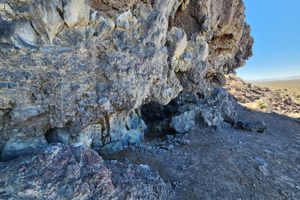
The first arrival of humans in the Americas is traditionally one of the most vexing questions in the archeology of the New World. For decades it was thought that the so-called Clovis culture, named after the area in New Mexico where its artifacts were first documented, was the first. This was a sophisticated hunting culture, characterized by beautifully chipped obsidian spear points, that is widely found across North America. The points are associated with bones of Pleistocene megafauna, suggesting that they were the prey. The most recent evidence indicates the oldest Clovis sites date to about 13,000 years before present (B.P.).
As the Ice Age waned, an ice-free corridor opened between the Cordilleran Ice Sheet on the west, covering the Rocky Mountains, and the Laurentide Ice Sheet on the east. It's thought that the ancestors of the Clovis people came in through this ice-free corridor while the Bering Strait was still dry land. They would have already honed their hunting skills in Asia.
Other migrants may have come into the Americas as well. For many years reports of pre-Clovis archeological sites were controversial, but it's now widely accepted that pre-Clovis human occupation occurred. The Paisley Five Mile Caves are now one of the best-documented pre-Clovis sites. This site lies on the east side of Pleistocene Lake Chewaucan, which filled the wide valley east of Winter Ridge. (The modern Summer Lake is a much-shrunken remnant of this ancient body of water.) Surf raised by westerly winds blowing across miles of lake water carved out overhangs and shelters in the shoreline rock. The rock is basalt with intercalated rubble zones and would have been easily eroded by heavy surf.
The Paisley caves contain coprolites—ancient fecal material—that yielded human DNA. Some of this material also yields carbon-14 ages over 14,000 years B.P., over a thousand years before the oldest documented Clovis sites. Although cultural materials such as bone tool fragments, wooden pegs, cordage fragments possibly from mats or baskets, and even fire hearths have been found, there is little evidence of extended habitation. The site seems to have been temporarily occupied, perhaps seasonally when particular resources were abundant.

Post a Comment